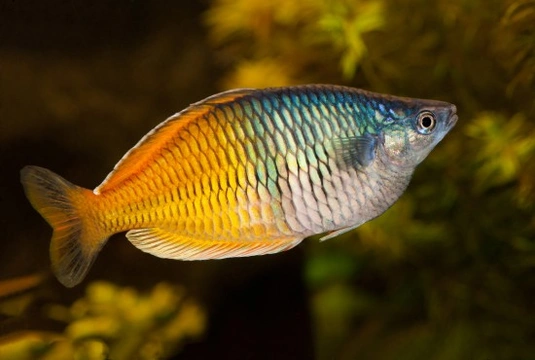
Feeding Rainbowfish successfully
The rainbowfish is one of the brightest, most colourful and beautiful of all of the freshwater aquarium fish, and one of the most popular among aquarium hobbyists who love bright, eye-catching fish but do not wish to keep a marine tank. While popular and readily available to buy from larger aquatic retailers, the rainbow fish is one of the more complex of the freshwater fish species, and particularly, they can prove very challenging to feed properly so that they thrive.
While many domestic pet fish are perfectly fine when fed a commercial flake or pellet diet for convenience, the rainbow fish is not among them, and in order to keep your rainbowfish healthy and colourful, they require a diet that is as near as possible to that which they would eat in the wild.
For this reason, many people keep rainbowfish in their own dedicated tank without other species, as feeding a generic diet can greatly shorten your fish’s lifespan.
In this article, we will look at how to successfully feed rainbowfish, to keep them healthy, colourful and well. Read on to learn more!
Rainbowfish feeding
The need to feed the rainbowfish a special diet is often overlooked, as rainbow fish will happily eat most things that you offer to them, leading owners to believe that the given food is suitable. However, just because your fish will eat something doesn’t mean that they should, and the key to good rainbow fish nutrition is a close mimicry of their natural feeding habitat. In the wild, rainbow fish eat a variety of foods including tadpoles, insects and very small fish, as well as plants and algae. The bulk of their wild diet consists of algae, and this is what you should aim to achieve within your own tank.
While regular flaked fish food does contain some algae content, this is usually fairly low, and not satisfactory for rainbowfish. At a pinch you can feed flaked food that is particularly good quality with a high algae content, but this is not really sufficient long term. Generic flaked food generally contains more meat and fish-based matter than algae, as most fish are highly omnivorous. This diet is protein rich and low in fibre, which is the opposite of the rainbowfish’s requirements, and will not allow them to thrive.
While feeding high protein and low fibre will make your rainbow fish grow larger, this does not mean that your fish are thriving; while in the short term they may appear to be bright and healthy, long term, this type of diet can lead to a multitude of health problems, and shorten your fish’s lifespan.
Good food for rainbowfish
In order to feed your rainbowfish as natural a diet as possible, it is a good idea to actively encourage algae growth within the aquarium, when usually, doing the exact opposite is the best idea for other fish! This does mean that the tank furniture and possibly sides of the tank will show visible algae growth and look a bit green and murky, but keeping the front face of the tank free of algae while allowing it to grow on other surfaces can ensure that you can still view your fish properly.
Permitting algae growth will allow your fish to go about their natural feeding behaviour, which takes the form of grazing and foraging. You should also combine a range of fresh vegetables into your fish’s diet as well as the algae, such as by offering aubergine, pumpkin and other squashes, and peas.
While algae and veg should form the main part of your fish’s diet, they do still need to have this food supplemented by protein and meat products. Meat and fish based foods should account for around 30% of your rainbowfish’s diet, but never more than 40% in total. You can provide meat for your fish by feeding mosquito larvae, shrimp and other morsels, but steer clear of anything fatty.
Seasonal feeding
The natural habitat of rainbowfish in the wild is subject to significant seasonal variations, with wet and dry seasons that affect the availability of different types of foods. During the wet season, the availability of all sorts of food will increase exponentially, as insects, tadpoles and fish fry all hatch in the water, providing plenty of dietary protein for the fish. During the dry season when such food is less readily available, the percentage of algae in the rainbow fish’s diet will rise, but even in the wet season, algae should still form the bulk of their diet.
Mimicking the wet and dry seasons when it comes to feeding your rainbowfish can help to induce breeding and mating behaviour in your fish, as this occurs during the wet season when protein is plentiful. This means that you my wish to adjust the levels of protein within your fish’s diet at different times of the year, in order to provide as natural an environment as possible and hopefully, produce fry!



